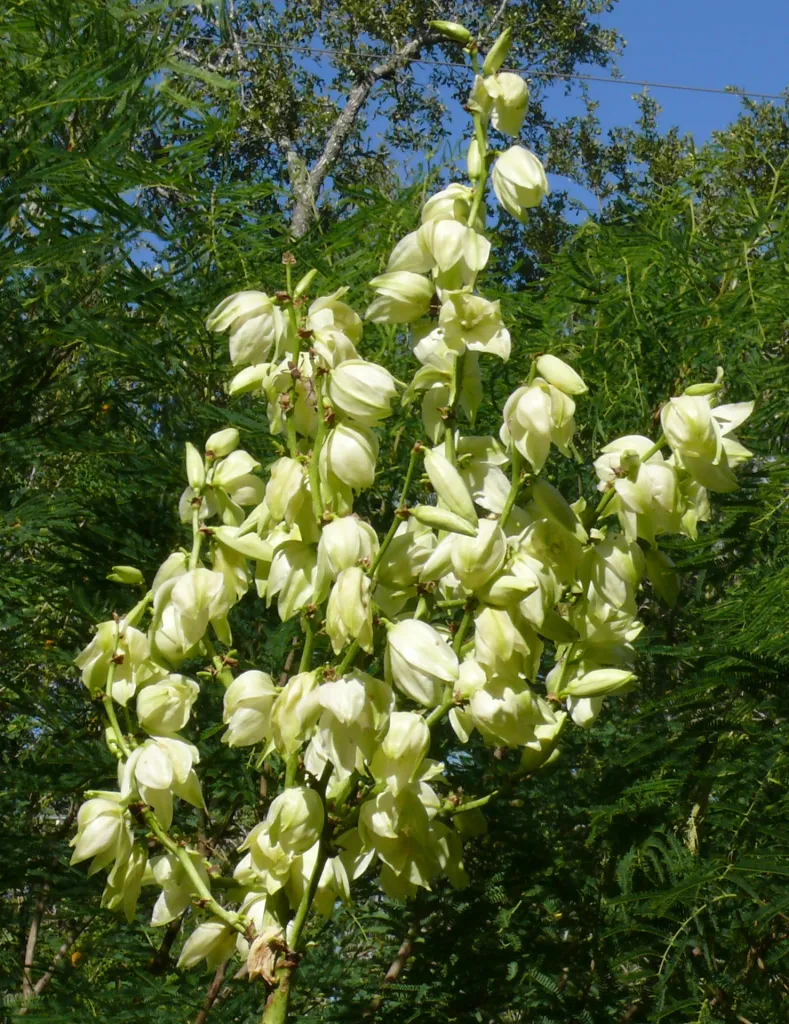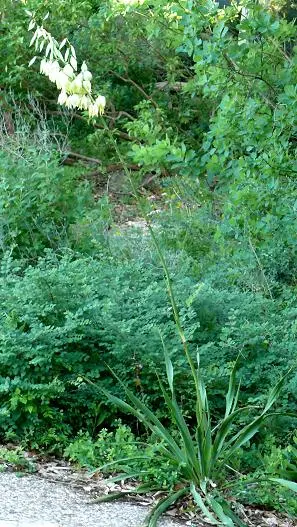Author: Bill Ward
Operation NICE! (Natives Instead of the Common Exotics!) starts the new year with yucca, a plant that is very Texan and very NICE!. Yuccas grow in all parts of Texas; there are 16 species native to the state. Once established in a yard or garden, yuccas require very little care of any kind, and, most importantly, they grow without irrigation. Aquifer-conserving landscape plants are increasingly more desirable in the Hill Country.
Yuccas come in enough varieties that almost any yard can include a species or two to good effect. There are small yuccas that are a foot or two high and large yuccas that grow up to 25 feet tall. There are yuccas with hard dagger-like leaves and yuccas with soft pliable leaves. For our climate most yuccas are sufficiently cold-hardy, and they are evergreen so they stand out in a winter landscape.

Four species of yucca are native to this area. The twist-leaf yucca (Yucca rupicola) is low-growing with “soft” twisting leaves. In the late spring it sends up a bloom stalk with white bell-shaped flowers. This Hill Country endemic can grow and bloom just fine in shady areas under live oaks. In my experience, this is one yucca that can be successfully transplanted from the wild. Other yuccas have deep taproots that make transplanting difficult or impossible.
Another common Hill Country plant is Buckley yucca (Y. constricta). This grows as tight balls of slender leaves up to two feet long. The leaves are characterized by curly threads along the edges. In time, this yucca may develop a short trunk. The bloom stalk is multibranched and crowded with white flowers.
A similar thin-leaf yucca also growing in this area is the Arkansas yucca (Y. arkansana). This species, too, has whitish curly fibers along leaf margins, but differs from Buckley yucca in having a typically unbranched bloom stalk.
Spanish dagger (Y. treculeana) is a broader-leaf yucca growing throughout South Texas up to the southeastern Edwards Plateau. It may be tree-like, up to 20 feet tall. The ones in this area tend to be shorter with stocky trunks. The spectacular clusters of cream-colored blossoms may be 3 feet high and 2 feet broad.

Some of our indigenous yuccas may not be available in the nursery trade, but most nurseries carry similar species. A popular landscape yucca available in nurseries is pendulous yucca (Y. recurvifolia), a native of the southeastern US. This species has flexible leaves and grows into a 4- to 6-foot shrub. Other southeastern US yuccas cultivated in Texas are Spanish bayonet (Y. aloifolia) and another Spanish dagger (Y. gloriosa). These species probably require a little more water than our native species.
Highly drought-tolerant species from Trans Pecos Texas may be available in nurseries from time to time. Boerne Chapter member Becky Eterno recommends banana yucca (Y. baccata), beaked yucca (Y. rostrata), and Thompson yucca (Y. thompsoniana) as desirable landscape plants.
Deer browsing of yucca foliage generally is not a problem, but yucca blossoms are the chocolate candy of the deer herds. As soon as I see the first sign of bloom stalks growing from our twist-leaf yuccas, I put up temporary wire-fence exclosures. That’s the only way we get to enjoy those pretty white flowers.
Yuccas apparently are tolerant of poor soils and many grow in full sun to part shade. All in all, they are very easy to grow. The Boerne Chapter of the Native Plant Society of Texas provides free planting and care instructions for yuccas at nurseries participating in Operation NICE! (Hill Country African Violets & Nursery and Maldonado Landscape & Nursery).
American Indians recognized the value of native yuccas. They used nearly every part of the plants. According to “Texas Trees – a Friendly Guide” by Paul Cox and Patty Leslie, the trunks were used for stockades, and leaves, for thatching huts. Yucca flowers were eaten raw, boiled, or pickled. A soap for washing hair and clothes was made from the roots. In Mexico leaf fibers still are used for making twine, rope, cloth, mats, sandals, and saddle blankets.
